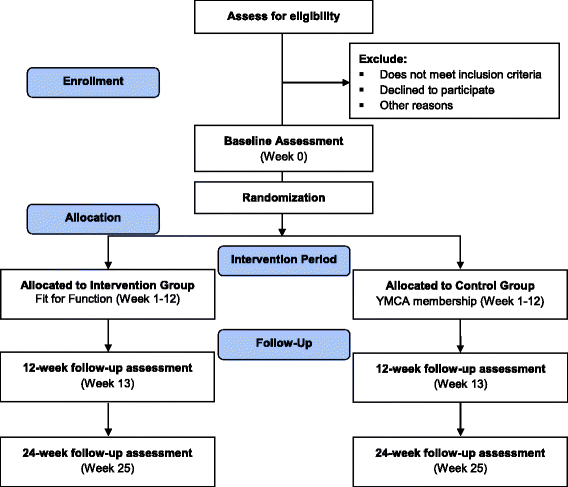FIT for FUNCTION: study protocol for a randomized controlled trial
- PMID: 29335013
- PMCID: PMC5769391
- DOI: 10.1186/s13063-017-2416-3
FIT for FUNCTION: study protocol for a randomized controlled trial
Abstract
Background: The current state of evidence suggests that community-based exercise programs are beneficial in improving impairment, function, and health status, and are greatly needed for persons with stroke. However, limitations of these studies include risk of bias, feasibility, and cost issues.
Methods/design: This single-blinded, randomized controlled trial (RCT) of 216 participants with stroke will compare the effectiveness of a 12-week YMCA community-based wellness program (FIT for FUNCTION) specifically designed for community-dwelling persons with stroke to persons who receive a standard YMCA membership. The primary outcome will be community reintegration using the Reintegration to Normal Living Index at 12 and 24 weeks. Secondary outcomes include measurement of physical activity level using the Rapid Assessment of Physical Activity and accelerometry; balance using the Berg Balance Scale; lower extremity function using the Short Physical Performance Battery; exercise capacity using the 6-min walk test; grip strength and isometric knee extension strength using hand held dynamometry; and health-related quality of life using the European Quality of Life 5-Dimension Questionnaire. We are also assessing cardiovascular health and lipids; glucose and inflammatory markers will be collected following 12-h fast for total cholesterol, insulin, glucose, and glycated hemoglobin. Self-efficacy for physical activity will be assessed with a single question and self-efficacy for managing chronic disease will be assessed using the Stanford 6-item Scale. The Patient Activation Measure will be used to assess the patient's level of knowledge, skill, and confidence for self-management. Healthcare utilization and costs will be evaluated. Group, time, and group × time interaction effects will be estimated using generalized linear models for continuous variables, including relevant baseline variables as covariates in the analysis that differ appreciably between groups at baseline. Cost data will be treated as non-parametric and analyzed using a Mann-Whitney U test.
Discussion: This is a RCT with broad study eligibility criteria intended to recruit a wide spectrum of individuals living in the community with stroke. If positive benefits are demonstrated, results will provide strong research evidence to support the implementation of structured, community-based exercise and education/self-management programs for a broad range of people living in the community with stroke.
Trial registration: ClinicalTrials.gov, NCT02703805 . Registered on 14 October 2014.
Keywords: Community-based programs; Exercise; Function; Reintegration; Stroke.
Conflict of interest statement
Ethics approval and consent to participate
All participants, including individuals and staff who delivered the interventions, provided written consent to participate in the trial. Ethics approval for this study was provided by the Hamilton Integrated Research Ethics Board, REB Project #14-388.
Consent for publication
Not applicable
Competing interests
The authors declare that they have no competing interests.
Publisher’s Note
Springer Nature remains neutral with regard to jurisdictional claims in published maps and institutional affiliations.
Figures


References
-
- Public Health Agency of Canada . Tracking heart disease and stroke in Canada. Edmonton, AB: Public Health Agency of Canada; 2011.
Publication types
MeSH terms
Associated data
Grants and funding
LinkOut - more resources
Full Text Sources
Other Literature Sources
Medical

